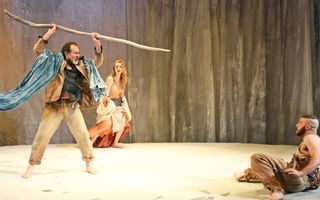 Watch
Watch
The Tempest was most likely written around 1610-1611, during the reign of King James I, and is often considered the last play Shakespeare wrote as the sole playwright.
Its first recorded performance was on Hallowmas (1st of November) in 1611, at Whitehall. It was probably also performed at the Globe Theatre and may be the only one of Shakespeare’s works written specifically for the Blackfriars, an indoor theatre used by Shakespeare’s company from 1608. A court performance was also recorded in 1613, as part of the wedding celebrations of King James’ daughter Elizabeth. The only authoritative version of the text is that of the First Folio, published in 1623, in which it is famously the first play printed in the book.
A number of accounts of shipwrecks and travels to exotic islands were published around the time Shakespeare was writing The Tempest. In 1610, two accounts of sea voyages were recorded that seem likely to have influenced his work: Silvester Jourdain’s A Discovery of the Barmudas and William Strachey’s A True Reportory of the Wracke, which described a group of sailors, believed lost, who made their way back to civilisation.
Although such popular tales may have inspired Shakespeare, The Tempest is one of very few plays for which the plot appears to have been his own invention, rather than an adaptation of an existing story. The only other plays that appear to be Shakespeare’s own invention are Love’s Labours Lost, A Midsummer Night’s Dream, and The Merry Wives of Windsor. However, certain passages have been linked to existing sources such as Montaigne’s Of Cannibals, which discusses foreign cultures and utopian ideals, Erasmus’s Colloquia Familiaria and Ovid’s Metamorphoses. There is also a growing acceptance that Virgil’s Aeneid, the story of a Trojan hero’s wanderings after the Trojan War, was influential in Shakespeare’s description of the storm, the magical banquet disturbed by Ariel, and in Ferdinand’s mistaking of Miranda for a goddess.
Beyond specific sources, there is no doubt that The Tempest touches on fashionable topics that were in high circulation during this time. New World colonies, such as Virginia in the Americas, were being established, and with this came both fear and fascination. The educated at the time upheld Renaissance ideas of strict hierarchy, with nature and the animal at the bottom, progressing upward through man and the rational, towards the divine. On the contrary, utopian ideals that placed natural ‘savagery’ above civilisation were also of growing interest. The Tempest considers all of these, but is careful to restore ‘civilised’ order at its end.
The play has a complex performance history, in which, up until the mid-1800s, rewritings, parodies and adaptations were more often seen on the stage than the original text. In the 1660s John Dryden and William Davenant adapted a version, called The Enchanted Island, which appealed to the upper class’s ideals of the monarch’s superiority and patriarchal authority over property. Composer Thomas Shadwell added music to the show and it became an operatic hit, featuring Ariel as a singing, dancing female sprite, Caliban as a highly comedic character with an absurd physicality and big-budget special effects. In the 1840s a strong resurgence and interest in Shakespeare’s version returned with the social and political response to slavery, and the play has continued to be viewed through various political, scientific and social lenses ever since. The rise of post-colonial theory in the mid-20th century saw a huge shift in how the role of Caliban was addressed, and this has mostly dominated audience experiences of the play until today






